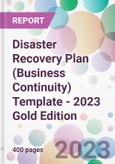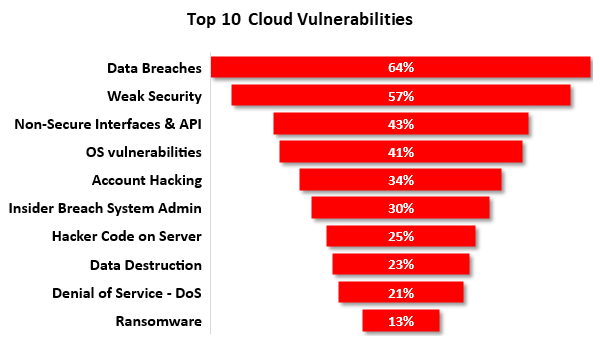DRP BCP Tool Kit fully integrated with IT Infrastructure Policies - Cloud DR/BC supported
The Disaster Recovery Business Continuity Template 2023 Gold Edition includes both the FULL DRP template in MS WORD format and the Internet and IT Position Descriptions which comes as over 324 individual WORD files - one for each job description and includes all of the job descriptions for in the PREMIUM Edition. Long file names have been used to make customization easier.
ISO 27000, CCPA, GDPR, SOX, PCI-DSS & HIPAA Compliant
The Standard for Disaster Planning and Continuity Planning - Just added WFH & Telecommuting Policy
Over 3,000 Companies World Wide have chosen this DRP/BCP Template - comes in MS Word, ePub (eReaders), and PDF formats.
In most organizations, Disaster Recovery Planning is the quintessential complex, unfamiliar task. Disasters happen so rarely that recovery operations are the opposite of routine. What's more, the myriad of interconnected data, applications and other resources that must be recovered after a disaster make recovery an exceptionally difficult and error-prone effort. Even if you have never built a Disaster Recovery plan before, you can achieve great results. Just follow the DR Template that Janco has created and you will have a functioning plan before you know it.
All Business Continuity Disaster Recovery Planning efforts need to encompass how employees will communicate, where they will go and how they will keep doing their jobs. The details can vary greatly, depending on the size and scope of a company and the way it does business. For some businesses, issues such as supply chain logistics are most crucial and are the focus on the plan. For others, information technology may play a more pivotal role, and the Business Continuity Disaster Recovery Plan may have more of a focus on systems recovery.
Vendor Partner QuestionnaireBut the critical point is that neither element can be ignored, and physical, IT and human resources plans cannot be developed in isolation from each other. (In this regard, Business Continuity Planning and Disaster Recovery Planning have much in common with security convergence.) At its heart, Business Continuity Planning and Disaster Recovery Planning processes are about constant communication.
The Disaster Recovery Plan (DRP) is a tool that can be used as a Disaster Planning Template for any size of the enterprise. The Disaster Planning Template and supporting material have been updated to be GDPR, CCPA, Sarbanes-Oxley and HIPAA compliant. The template comes as both a Word document, a static fully indexed PDF document, and an electronic book in .epub format.
The Disaster Planning and Business Continuity Planning Template include:
- Business Continuity Plan Activation Process
- Using Cloud for DR/BC
- Work From Home Lessons Learned
- A Vendor Partner DR/BC Questionnaire as an electronic form
- Full job descriptions for Disaster Recovery Manager, Pandemic Coordinator, and Manager DR/BC
- Six (5) full infrastructure procedures:
- WFH & Telecommuting Policy
- Backup and Backup Retention Policy
- Incident Communication Plan Policy
- Physical and Virtual Server Security Policy
- Social Networking Policy
- Twenty-Two (22) electronic forms
Preparation for Disaster Recovery and Business Continuity in light of mandated requirements has two primary parts. The first is putting systems in place to completely protect all financial and other data required to meet the reporting regulations and to archive the data to meet future requests for clarification of those reports. The second is to clearly and expressly document all these procedures so that in the event of a SOX audit, the auditors clearly see that the Disaster Recovery and Business Continuity Plan exists and appropriately protects the data and assets of the enterprise.
Table of Contents
1. Plan Introduction
1.1 Recovery Life Cycle - After a "Major Event"
1.2 Mission and Objectives
1.3 Disaster Recovery/Business Continuity Scope
1.4 Authorization
1.5 Responsibility
1.6 Key Plan Assumptions
1.7 Disaster Definition
1.8 Metrics
1.9 Disaster Recovery/Business Continuity and Security Basics
2. Business Impact Analysis
2.1 Scope
2.2 Objectives
2.3 Analyze Threats
2.4 Critical Time Frame
2.5 Application System Impact Statements
2.6 Information Reporting
2.7 Best Data Practices
2.8 Summary
3. Backup Strategy
3.1 Site Strategy
3.2 Backup Best Practices
3.3 Data Capture and Backups
3.4 Communication Strategy
3.5 Enterprise Data Center Systems - Strategy
3.6 Departmental File Servers - Strategy
3.7 Wireless Network File Servers - Strategy
3.8 Data at Outsourced Sites (Including ISP’s) - Strategy
3.9 Branch Offices (Remote Offices & Retail Locations) - Strategy
3.10 Desktop Workstations (In Office) - Strategy
3.11 Desktop Workstations (Off-Site Including At-Home Users) - Strategy
3.12 Laptops - Strategy
3.13 PDA’s and Smartphones - Strategy
3.14 Byods - Strategy
3.15 IoT Devices - Strategy
4. Recovery Strategy
4.1 Approach
4.2 Escalation Plans
4.3 Decision Points
5. Disaster Recovery Organization
5.1 Recovery Team Organization Chart
5.2 Disaster Recovery Team
5.3 Recovery Team Responsibilities
5.3.1 Recovery Management
5.3.2 Damage Assessment and Salvage Team
5.3.3 Physical Security
5.3.4 Administration
5.3.5 Hardware Installation
5.3.6 Systems, Applications, and Network Software
5.3.7 Communications
5.3.8 Operations
6. Disaster Recovery Emergency Procedures
6.1 General
6.2 Recovery Management
6.3 Damage Assessment and Salvage
6.4 Physical Security
6.5 Administration
6.6 Hardware Installation
6.7 Systems, Applications & Network Software
6.8 Communications
6.9 Operations
7. Plan Administration
7.1 Disaster Recovery Manager
7.2 Distribution of the Disaster Recovery Plan
7.3 Maintenance of the Business Impact Analysis
7.4 Training of the Disaster Recovery Team
7.5 Testing of the Disaster Recovery Plan
7.6 Evaluation of the Disaster Recovery Plan Tests
7.7 Maintenance of the Disaster Recovery Plan
8. Appendix A - Listing of Attached Materials
8.1 Disaster Recovery Business Continuity - Electronic Forms
- Site Evaluation Checklist
- Lan Node Inventory
- Location Contact Numbers
- Off-Site Inventory
- Pandemic Planning Checklist
- Personnel Location
- Plan Distribution
- Remote Location Contact Information
- Server Registration
- Team Call List
- Vendor Contact List
- Vendor/Partner Questionnaire
- Work from Home Contact Information
8.2 Safety Program Forms - Electronic Forms
- Area Safety Inspection
- Employee Job Hazard Analysis
- First Report of Injury
- Inspection Checklist - Alternative Locations
- Inspection Checklist - Computer Server Data Center
- Inspection Checklist - Office Locations
- New Employee Safety Checklist
- Safety Program Contact List
- Training Record
8.3 Business Impact Analysis - Electronic Forms
- Application and File Server Inventory
- Business Impact Questionnaire
8.4 Job Descriptions
- Disaster Recovery Manager
- Manager Disaster Recovery and Business Continuity
- Pandemic Coordinator
8.5 Attached Infrastructure Policies
- Backup and Backup Retention Policy
- Incident Communication Plan Policy
- Physical and Virtual Server Security Policy
- Social Networking Policy
8.6 Other Attachments
- Disaster Recovery Business Continuity Audit Program
9. Appendix B - Reference Materials
9.1 Preventative Measures.
9.2 Sample Application Systems Impact Statement
9.3 Key Customer Notification List
9.4 Resources Required for Business Continuity
9.5 Critical Resources to Be Retrieved
9.6 Business Continuity Off-Site Materials
9.7 Work Plan
9.8 Audit Disaster Recovery Plan Process
9.9 Departmental DRP and BCP Activation Workbook
9.10 Web Site Disaster Recovery Planning Form
9.11 General Distribution Information
9.12 Disaster Recovery Sample Contract
9.13 Ransomware - HIPAA Guidance
9.14 Power Requirement Planning Check List
9.15 Colocation Checklist
10. Change History
Samples

LOADING...
Executive Summary
Disaster Recovery/Business Continuity Plan Released along with Cloud based DR/BC and Security Compliance Templates
The focus of these updates is using the Cloud for DR/BC while meeting compliance mandates.
The CEO of Janco, M. Victor Janulaitis said, “IT managers have eagerly implemented cloud applications to reap its many benefits including lower hardware, infrastructure, and energy costs. Now the focus is on having DR/BC Plans that utilize cloud processing as a top priority.” He added, “The recent storms in Texas have shown many CIOs that DR/BC at a time when working from home is the norm, processing plans need to be more resilient. With the current editions of our Cloud, DR/BC, and Security Templates we have addressed those needs directly.”
These core documents are delivered electronically along with specific infrastructure procedures, job descriptions and electronic forms. In addition, there are over 200 pages of additional supporting materials that can be used by companies to update their existing DR/BC plans and Security protocols. Being modular in nature, Janco’s full bundle does not need to be implemented. Rather components of the How to Cloud Guide, DR/BC, and Security Templates can be extracted and added to existing infrastructure and plans.
This Edition has detailed DR/BC activation procedures and implementation work plans. The bundle of three templates provides clear examples of how to get something done quickly and efficiently given the needs of today’s complex operating environments. Any sized organization can benefit from this tool. It is comprehensive and the processes created are concise and easily implemented. There are checklists and examples of what is needed to get systems and networks working quickly.










